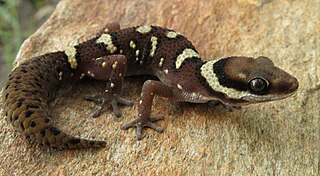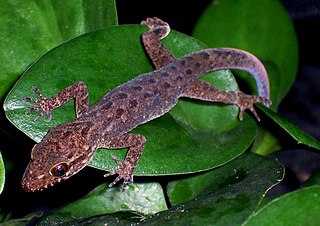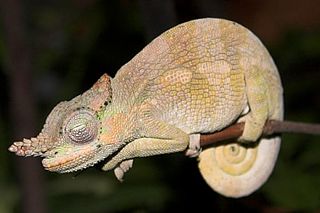
Gekkonidae is the largest family of geckos, containing over 950 described species in 64 genera. Members of the Gekkonidae comprise many of the most widespread gecko species, including house geckos (Hemidactylus), tokay geckos (Gekko), day geckos (Phelsuma), mourning geckos (Lepidodactylus) and dtellas (Gehyra). Gekkonid geckos occur globally and are particularly species-rich in tropical areas.

Lygodactylus is a genus of diurnal geckos with 72 species. They are commonly referred to as dwarf geckos. They are mainly found in Africa and Madagascar although two species are found in South America. Lygodactylus picturatus, the best known species, is found in Kenya and commonly known as the white-headed dwarf gecko. Recently, illegal importation from Tanzania of brightly colored, Lygodactylus williamsi, known as electric blue geckos, has been gaining attention for Lygodactylus geckos in the reptile trade.

Hemidactylus is a genus of the common gecko family, Gekkonidae. It has 183 described species, newfound ones being described every few years. These geckos are found in all the tropical regions of the world, extending into the subtropical parts of Africa and Europe. They excel in colonizing oceanic islands by rafting on flotsam, and are for example found across most of Polynesia. In some archipelagoes, cryptic species complexes are found. Geckos like to live in and out of houses. They have been introduced to Australia.

Pachydactylus is a genus of insectivorous geckos, lizards in the family Gekkonidae. The genus is endemic to Africa, and member species are commonly known as thick-toed geckos. The genus also displays rich speciation, having 57 distinct species identified when compared to other closely related gecko genera like Rhoptropus, most of which have emerged since 35Ma. It has been suggested that the reason for this rich speciation not from adaptive radiation nor nonadaptive radiation, but that the genus represents a clade somewhere between the two drivers of speciation. P. bibronii geckos have been used by NASA as animal models for experimentation.

Cnemaspis is a genus of diurnal (day) geckos found in Asia. With over 100 species, it is one of the most diverse genera of geckos. Molecular phylogenies suggest that the two regional groupings may form distinct clades which are not each other's closest relatives.

Cyrtodactylus is a diverse genus of Asian geckos, commonly known as bent-toed geckos, bow-fingered geckos, and forest geckos. The genus has at least 300 described species as of 2020, which makes it the largest of all gecko genera.
Goggia, also known commonly as dwarf leaf-toed geckos or pygmy geckos, is a genus of African geckos, lizards in the family Gekkonidae.

Adolfus is a genus of lizards of the family Lacertidae. The genus is endemic to subsaharan Africa.

Kinyongia is a chameleon genus recently established for several plesiomorphic species found in forest and woodland in Kenya, Tanzania, Uganda, Rwanda, and far eastern DR Congo. All except K. adolfifriderici and K. tavetana are restricted to highlands, and many have very small geographic ranges. In most, at least the males have horns or knobs on their noses. They had been placed into the genus Bradypodion for some time. It has recently been pointed out that the ending to the specific epithet in several of the below listed species should be modified to match the feminine genus name.
Letheobia is a genus of blind snakes in the family Typhlopidae.
The African gecko is a species of gecko found in Central Africa. Two subspecies have been described.
Richard Sternfeld was a German-Jewish herpetologist, who was responsible for describing over forty species of amphibians and reptiles, particularly from Germany's African and Pacific colonies.
Ancylodactylus barbouri, also known commonly as Barbour's gecko, is a species of lizard in the family Gekkonidae. The species is endemic to Tanzania.
Ancylodactylus dickersonae, also known commonly as Dickerson's forest gecko, Dickerson's gecko, and the four-lined forest gecko, is a species of lizard in the family Gekkonidae. The species is endemic to Africa.

Koehler's gecko is a species of gecko, a lizard in the family Gekkonidae. The species is endemic to Central Africa.
Sternfeld's gecko is a species of geckos found in central Africa.

Ancylodactylus gigas, also known as Perret's Nigeria gecko or giant forest gecko, is a species of gecko endemic to Nigeria.
Ancylodactylus petrodroma, also known as the Nigeria crag gecko or Ondo forest gecko, is a species of gecko endemic to Nigeria.
Scheffler's dwarf gecko is a species of lizard in the family Gekkonidae. The species is native to East Africa. There are three recognized subspecies.








